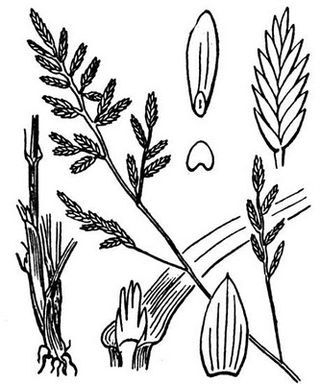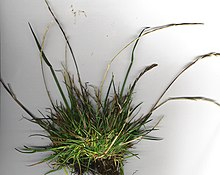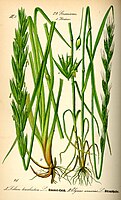
Fusarium patch is a disease in turf grass settings also called pink snow mold or Microdochium patch. In many cool season grass species in North America, it is caused by the fungus Microdochium nivale. The white-pink mycelium on infected leaf blades is a distinguishing characteristic of the Microdochium nivale pathogen. Fusarium patch is considered economically important in the turf grass industry because of its tendency to cause significant injury to golf greens, thereby decreasing putting surface quality. Dissimilar from other snow molds, such as gray snow mold, Microdochium nivale does not need snow cover to cause widespread infection.

Vicia sativa, known as the common vetch, garden vetch, tare or simply vetch, is a nitrogen-fixing leguminous plant in the family Fabaceae. It is now naturalised throughout the world occurring on every continent, except Antarctica and the Arctic. The centre of diversity is thought to be the Fertile Crescent, although gold standard molecular confirmation is currently not available.

The Cyperaceae are a family of graminoid (grass-like), monocotyledonous flowering plants known as sedges. The family is large, with some 5,500 known species described in about 90 genera, the largest being the "true sedges" genus Carex with over 2,000 species.

Trifolium repens, the white clover, is a herbaceous perennial plant in the bean family Fabaceae. It is native to Europe, including the British Isles, and central Asia and is one of the most widely cultivated types of clover. It has been widely introduced worldwide as a forage crop, and is now also common in most grassy areas of North America, Australia and New Zealand. The species includes varieties often classed as small, intermediate and large, according to height, which reflects petiole length. The term 'white clover' is applied to the species in general, 'Dutch clover' is often applied to intermediate varieties, and 'ladino clover' is applied to large varieties.

Festuca (fescue) is a genus of flowering plants belonging to the grass family Poaceae. They are evergreen or herbaceous perennial tufted grasses with a height range of 10–200 cm (4–79 in) and a cosmopolitan distribution, occurring on every continent except Antarctica. The genus is closely related to ryegrass (Lolium), and recent evidence from phylogenetic studies using DNA sequencing of plant mitochondrial DNA shows that the genus lacks monophyly. As a result, plant taxonomists have moved several species, including the forage grasses tall fescue and meadow fescue, from the genus Festuca into the genus Lolium, or alternatively into the segregate genus Schedonorus.

Festuca pratensis, the meadow fescue, is a perennial species of grass, which is often used as an ornamental grass in gardens, and is also an important forage crop.
Rhynchosporium secalis is an ascomycete fungus that is the causal agent of barley and rye scald.

Epichloë is a genus of ascomycete fungi forming an endophytic symbiosis with grasses. Grass choke disease is a symptom in grasses induced by some Epichloë species, which form spore-bearing mats (stromata) on tillers and suppress the development of their host plant's inflorescence. For most of their life cycle however, Epichloë grow in the intercellular space of stems, leaves, inflorescences, and seeds of the grass plant without incurring symptoms of disease. In fact, they provide several benefits to their host, including the production of different herbivore-deterring alkaloids, increased stress resistance, and growth promotion.

Festuca arundinacea (syn., Schedonorus arundinaceus and Lolium arundinaceum) is a species of grass commonly known as tall fescue. It is a cool-season perennial C3 species of bunchgrass native to Europe. It is an important forage grass throughout Europe, and many cultivars have been used in agriculture. It is also an ornamental grass in gardens, and a phytoremediation plant.

Lolium multiflorum is a ryegrass native to temperate Europe, though its precise native range is unknown.

Catapodium is a genus of Eurasian and North African plants in the grass family.

Sesleria is a genus of perennial plants in the grass family. They are native to Eurasia and North Africa. They are found in Albania, Austria, Baleares, Baltic States, Belarus, Belgium, Bulgaria, Corsica, Czechoslovakia, East Aegean Islands, Finland, France, Germany, Great Britain, Greece, Hungary, Iceland, Iran, Ireland, Italy, Crete, Crimea, Lebanon, Morocco, North Caucasus, Poland, Romania, Sardina, Sicilia, Spain, Sweden, Switzerland, Syria, Transcaucasus, Turkey, Ukraine and Yugoslavia.
Dollar spot is a fungal disease of turfgrass caused by the four species in the genus Clarireedia, in the family Rutstroemiaceae. The pathogen blights leaf tissues but does not affect turf grass roots or crowns. There is evidence that a fungal mycotoxin produced by the pathogen may cause root damage, including necrosis of the apical meristem in creeping bentgrass. However, the importance of this toxin is unknown and its effects are not considered a direct symptom of dollar spot. The disease is a common concern on golf courses on intensely managed putting greens, fairways and bowling greens. It is also common on less rigorously maintained lawns and recreational fields. Disease symptoms commonly result in poor turf quality and appearance. The disease occurs from late spring through late fall, but is most active under conditions of high humidity and warm daytime temperatures 59–86 °F (15–30 °C) and cool nights in the spring, early summer and fall. The disease infects by producing a mycelium, which can be spread mechanically from one area to another.

Festuca gigantea, or giant fescue, is a plant species in the grass family, Poaceae. Because this and other members of Festuca subgenus Schedonorus have more in common morphologically with members of the genus Lolium than with Festuca and often produce fertile hybrids with other Lolium species, Festuca gigantea has been recently published as Lolium giganteum(L.) Darbysh. (1993) and then as Schedonorus giganteus(L.) Holub (1998). Sources vary as to which placement is more acceptable.

× Festulolium is a nothogenus of flowering plants in the grass family Poaceae. Naturally occurring hybrids, they are the result of crosses between species of two distinct grass genera, Festuca and Lolium, and the hybrids show phenotypic similarities to both parents. This type of intergeneric hybridization is quite rare, and is indicated by a multiplication symbol before the name. The name Festulolium is an example of a portmanteau word, a combination of the two parents' names.















